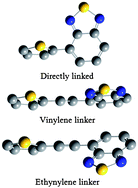Linker effects on optoelectronic properties of alternate donor–acceptor conjugated polymers†
Abstract
In this study, three

* Corresponding authors
a
Center for Advanced Photovoltaics, Department of Electrical Engineering and Computer Sciences, South Dakota State University, Brookings, SD, USA
E-mail:
Qiquan.Qiao@sdstate.edu
Fax: +1 605 688 4401
Tel: +1 605 688 6965
In this study, three

 Please wait while we load your content...
Something went wrong. Try again?
Please wait while we load your content...
Something went wrong. Try again?
J. Li, M. Yan, Y. Xie and Q. Qiao, Energy Environ. Sci., 2011, 4, 4276 DOI: 10.1039/C1EE02055B
To request permission to reproduce material from this article, please go to the Copyright Clearance Center request page.
If you are an author contributing to an RSC publication, you do not need to request permission provided correct acknowledgement is given.
If you are the author of this article, you do not need to request permission to reproduce figures and diagrams provided correct acknowledgement is given. If you want to reproduce the whole article in a third-party publication (excluding your thesis/dissertation for which permission is not required) please go to the Copyright Clearance Center request page.
Read more about how to correctly acknowledge RSC content.
 Fetching data from CrossRef.
Fetching data from CrossRef.
This may take some time to load.
Loading related content
